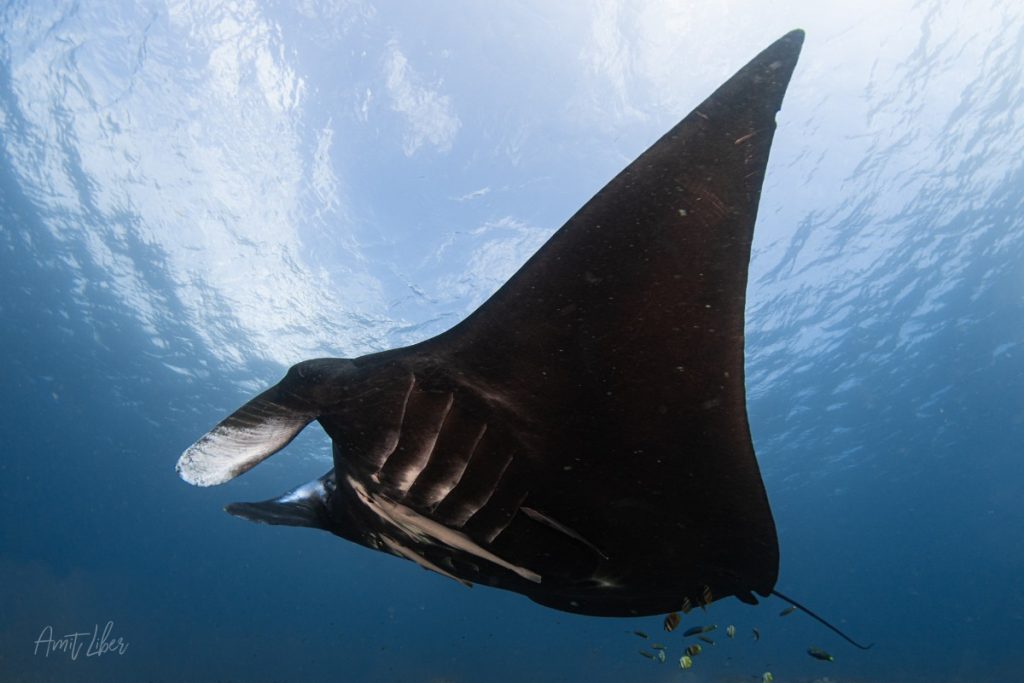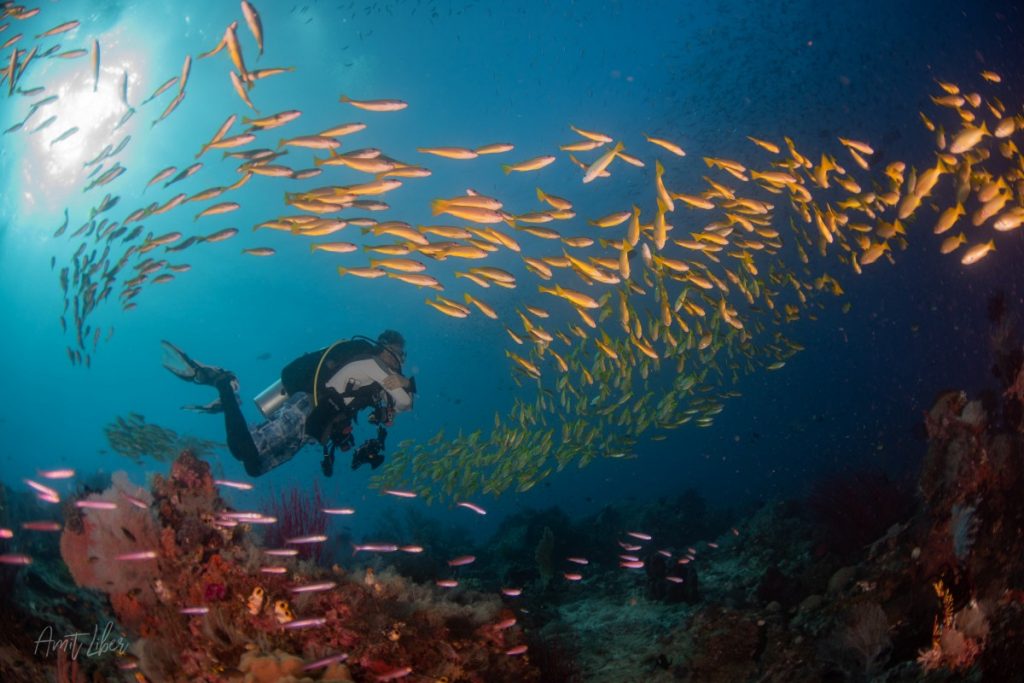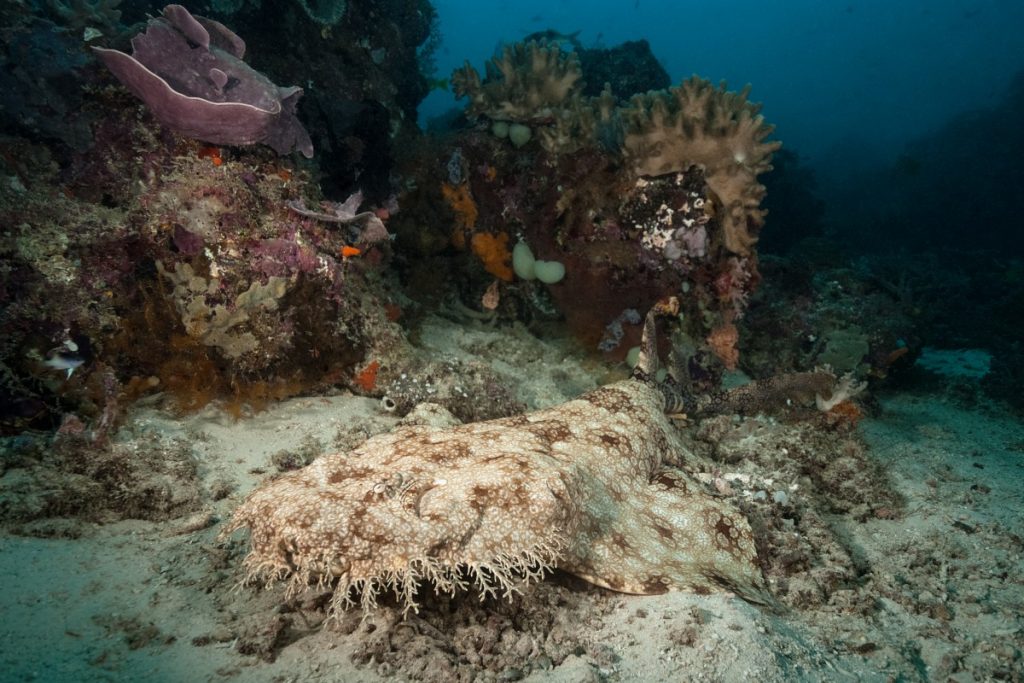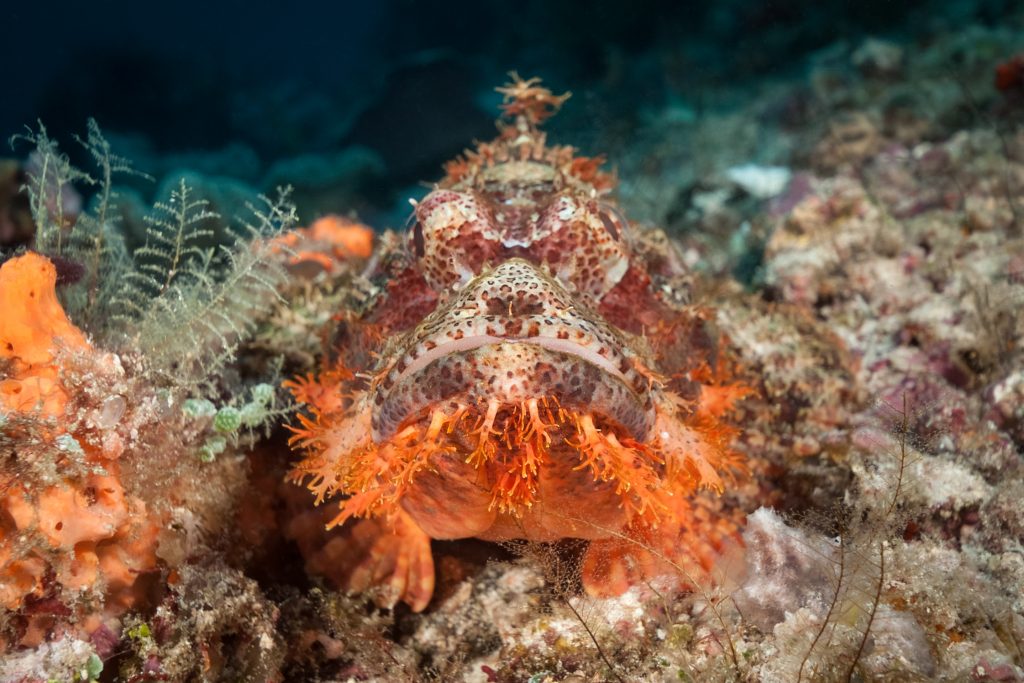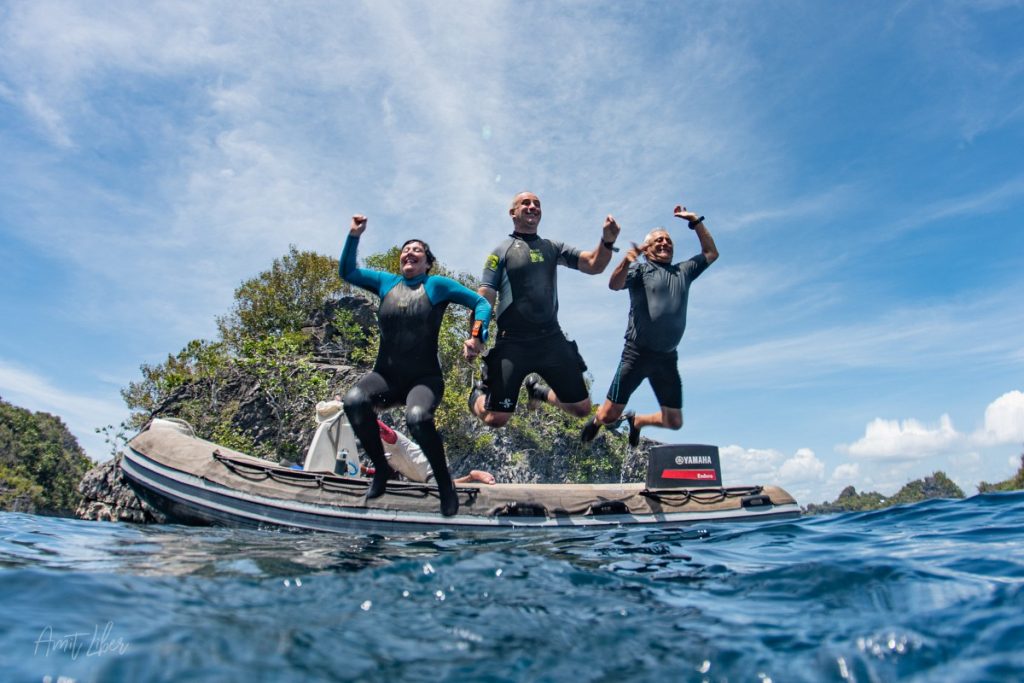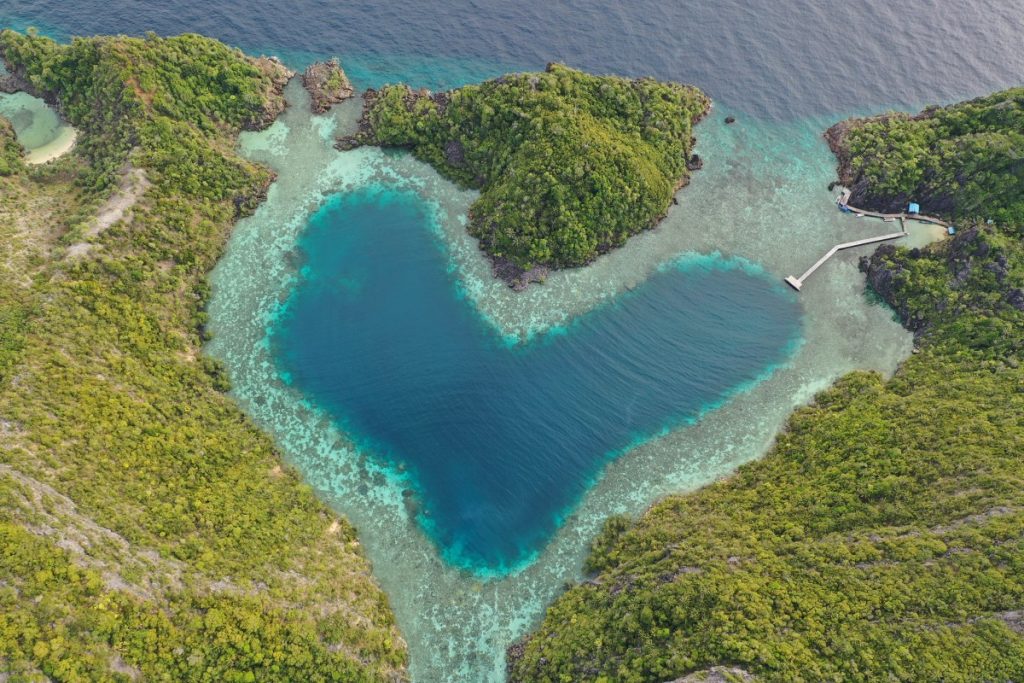Best of Raja Ampat
All Year | Sorong to Sorong
9 & 12 nights | Central, Northern and Southern sections.
Itinerary Highlights
- Centre of the Coral Triangle, Raja Ampat is the most biodiverse place on earth.
- Chance to see hammerheads, manta and other pelagic action combined with colourful pristine reefs.
- Be mesmerised by patrolling pelagics hunting their next meal.
- Discover something for the first time, a walking shark!
- Copious fish life, immense colours and mysterious critters, truly something for everyone.
- Misool’s sugarloaf islands, fifty shades of blue lagoons, deserted islands and dense, green mangroves.
Raja Ampat, which in Indonesian means the Four Kings, is a Marine Park world renowned for being the epicentre of marine biodiversity. The park covers a large area with approximately 170 nautical miles separating the northern and southern extremities. It would be possible to dive for weeks and weeks without seeing the same sites twice.
Raja Ampat can be divided into three sections covering the North, Central and Southern Sections. Spectacular scenery both above and below the water make this heritage area unique and a bucket list item for both divers and lovers of nature.
Our 9-night trips take in the central and either northern or southern sections – depending on the season – with the 12-night cruises visiting all three.
- Northern Section: Wayag, Kawe, Aljui Bay
- Central Section: Gam, Penemu, Arborek, Cape Kri Area/Dampier Strait
- Southern Section: Daram, Wayilbatan, Fiabacet, Pelee
Explore the map below for dive sites and descriptions.
Land visits: A walk to the panorama of Penemu, with stunning views of the lagoon and limestone rocks
*Please be aware the dive sites and areas mentioned in our itineraries are not guaranteed. They are subject to change based on weather conditions and are at the discretion of our cruise director/captain. This is to ensure we provide the best sightings and activities possible during your dive experience while also prioritising your safety.
Dive Sites
Click dive site markers for detailed descriptions.
Dive sites & areas that we may visit are subject to weather conditions.
Gam
- Citrus Ridge -
Citrus Ridge is one of the most stunning dive sites in Raja Ampat. The ridge with sloping sides is completely covered with marine life. The shallow bommies offer the most impressive and colorful orange coral, and the action overhead with schools of barracuda, giant trevally, fusilier and other reef sharks make it a dream for divers.
- Dalam -
Located in Yanggefo Island, on the west side of Gam, Batu Dalam a.k.a. Deep Rock is a submerged plateau covered with soft and hard coral, beautiful bommies and seafans. Schools of fusiliers, giant trevally, and barracuda dance in the current, while wobbegong sharks can be found hiding under table corals.
- Mayhem -
Mayhem is a large long subemerged pinnacle which lies along the western edge of the Dampier strait, just off the Island of Gam. Large schools of fish will enjoy the beautiful edge of the reef when the current is slow, which creates a magic ambiance. This site has a great variety of encounters, from large schools of fusiliers, snappers, jacks and batfish to wobbegongs and pygmy seahorses on the bottom.
Penemu
Located in the archipelago of Gam, Penemu (or Piaynemo in Indonesian) is sculpted by various bays and inner lagoons and owes to its very special shape. Famous for its limestone rocks with sugarloaf shapes and nice beaches, Penemu also has magnificent reefs.
Non-Diving Excursions: A walk to the panorama of Penemu, with stunning views of the lagoon and limestone rocks.
Here are some possible dive sites you may visit:
- Barracuda Point -
Barracuda point is a long and oval shaped reef in the northen tip of Penemu. Huge schools of fish especially barracuda, fusiliers and bannerfish show up when the current is strong. Reef crevices are filled by batfish and surgeon fish waiting to be cleaned by the wrasse at their cleaning stations.
- Galaxy -
Galaxy is a very extensive reef running from north to south on the eastern side of Penemu. Its particular shape makes the spot special when the current is running with great fish action and beautiful soft coral covered bommies on the top of the reef.
- Melissa's Garden -
3 little rocks just off the coast of Keruo island hide a large reef which simply cannot be explored in just one dive. In the shallows is a healthy and vibrant coral garden with a field of blue, yellow and pink stag horn coral. Napoleon wrasse, trevallies and schools of fusiliers are common here. Underwater ridges provide a subway system for pelagics and sharks rising from the deep.
- My Reef -
Located on the southern side of Penemu Island is an underwater ridge with its peak 7m below the surface and covered with coral and surrounded by an impressive abundance of fish, such as yellow tail barracudas, jack fish, reef sharks and groupers.
Arborek
Arborek has excellent dive sites with lots of schooling fish. Mantas and stingrays are common here.
- Arborek Jetty -
Arborek Jetty is the entry to the village of Arborek, located at the south west corner of the Island. Lying on a sandy bottom, this dive site offers some pretty coral bommies where you can find wobbegong sharks relaxing, file fish and huge giant clams. Mantas have also been known to show up during dives, and on a night dive you might meet the Raja Epaulette shark.
- Lolasi -
Lolasi which means 'fusilier' in Papuan, is a hard coral seamount, located on the western side of Arborek. This site is full of marine life when the current is strong. The long reef is perfect for a drift dive full of action.
- Manta Sandy -
One of the iconic dive sites of Raja Ampat, Manta Sandy is a manta cleaning station, located in a sand channel that runs between coral bommies. Divers will enjoy the show of dancing mantas while staying behind dead coral blocks, where you might have the chance to also find some fantastic small critters like pygmy seahorse or pegasus fish.
Cape Kri Area
- Blue Magic -
This submerged ridge running east to west is composed mainly of hard corals with a few colorful bommies on the eastern end. An impressive variety of fish enjoy this spot such as tuna, jacks, barracuda, and fusiliers. You might also meet oceanic mantas at the cleaning station on the top of the seamount.
- Cape Kri -
Cape Kri in the Dampier Strait is one of the most famous dive sites of Raja Ampat. The reef is en extention of the south side of Kri Island and is one of the best sites for big fish in North Raja Ampat. Beautiful coral, the huge density and variety of fish including barracudas, sweetlips, emperor angelfish, snappers, giant trevally and grey reef sharks make this a site not to be missed.
- Chicken Reef -
Chicken Reef is a submerged pinnacle on the outskirts of Pulau Kri. Quite shallow, the slope is dotted with large coral bommies and plenty of critters can be found hiding within the gorgonian fans, anemones and soft coral formations.
- Mike's Point -
Mike's Point is famous for its strong currents and the pure density and variety of fish found here. A spectacular dive just of Kerupiar Island which was bombed by allied planes during WWII after being mistakenly identified as a Japanese Ship.
- Mioskon -
The Mioskon dive site offers a beautiful reef covered in the Northen Raja Ampat signature purple soft coral and schools of Yellow Snapper, Napoleon Wrasse, big groupers and Wobbegong sharks.
- Sardine Reef -
Sardine Reef is a highlight of the Dampier Strait area. An oval shaped reef patch, it sits right in the middle of the open ocean. Around the reef, schools of fusiliers, Surgeonfish, Snappers, Damselfish and butterflyfish surrounded by predators, such as Barracuda, Spanish Mackerel, Giant Trevallies and several types of Jacks. On occasion you might even find some Grey Reef Sharks cruising around.
Dampier Strait
The Dampier Strait flows between the mainland of West Papua and Batanta Island and the large island of Waigeo to the north. This strait has extremely rich marine life thanks to the large amount of water passing through.
Batanta
The Batanta sites are classic “muck dives”. You will see sloping black sand with algae patches and coral rubble, where a cursory look will make you wonder why you are there. But to the trained eye there is much to see and the key to a productive and enjoyable experience at Batanta is a good guide.
Daram
- Andiamo -
Andiamo is comprised of two small islets west of Candy Store. The marine life on the reef is magnificent, with healthy soft and hard corals, schools of fish such as fusillers, anchovies, barracuda and Jacks.
- Candy Store -
Enjoy one of the most beautiful walls in Southern of Raja Ampat with Candy Store. Clusters of fish gather on the north facing pinnacles such as fusillers, anchovies, giant trevally, spanish mackerel. Huge and beautiful elephant ear sponges, sea fans, and soft corals decorate the western end of the dive site.
- Two Tree -
Two Tree offers a rich plateau where you can spot schools of barracuda, trevally, beautiful soft coral, sea fans, black coral tree and octopus.
Fiabacet
Some examples of possible dive sites that you may visit:
- Boo Windows -
Boo Windows was named after the tunnels and the swim through piercing its shallow section. This amazing site has a dramatic topography. Following the ridge heading west, expect to see grey reef sharks, napoleon wrasse, schools of batfish, even ghost pipefish and leaf fish.
- Tank Rock -
Tank Rock (Batu Kecil) is one of the best dive sites in Raja Ampat. A submerged ridge connects Tank Rock to Nudi Rock, and with favorable conditions, you may even be able to dive all the way to Fiabacet’s middle island. It's one of the most extensive and wonderful reef systems in the area. Beautiful fish life surround stunning soft and hard corals.
- Nudi Rock -
Nudi Rock got its name because of the nudibranch-like shape of the island as well as the abundance of nudibranchs that can be found hiding in the corals. The submarine landscape, with soft corals and sea fans in some areas, and hard corals in other areas is fantastic. Find all kinds of fish here in abundance – anchovies, snappers, groupers, Napoleon wrasse, barracuda and tunas too.
- Magic Mountain (Shadow Reef) -
This seamount sits in the depths of Misool with its peak rising to 5 meters. A cleaning station for the different species, Magic Mountain has it all with biodiversity at its best here. Schools of trevalies, napoleon wrasse, groupers, different species of barracudas, sharks, Spanish mackerels, and last but not least Oceanic Manta Rays are often hovering around to get cleaned. Some dolphins and whale sharks have also been spotted there…
- Whale Rock -
Whale Rock has a great variety of pygmy seahorses (Denise or Barbiganti species). To explore this site, we will cross over a little channel in between two small islands. Linked together by an underwater reef and a pinnacle, Whale Rock is full of fish.
Balbulol
Some examples of possible dive sites that you may visit:
- No Contest -
No Contest is a captivating reef ridge dive with a sweet spot at its west end. The western edge is buoyed for easy descent and ascent. Here, you'll find two stunning pinnacles with dramatic undercuts, overhangs, and soft coral growth, attracting barracuda, trevally, batfish, and snappers. Exercise caution with strong currents, especially during ascent. Dive when the current is manageable, as it may pick up during the dive.
- Love Potion No 9 -
Explore this dive site by beginning on the island's NE-side. Head south to find the captivating "sweet spot," a long 3-peaked ridge that rises to within 12m of the surface. Cross a small 25m gap at the SE-corner to reach the ridge, adorned with stunning sea fans and soft corals. Return to the island's protection after admiring the ridge's beauty.
- Plateau -
The sweet spot is the "plateau" at the west tip of the island. Depending on the current, start diving from the north or south side, and let it carry you around to the west tip. Expect abundant soft corals, fans, and schooling fish here. The plateau's top is at around 8m depth. It's a great alternative dive when "No Contest" or "Love Potion #9" are not suitable due to strong currents.
- Pet Rock -
Start on the island's NW-side, swimming west along the adorned wall. At the W-corner, head about 25-30 meters away to find a twin-peaked pinnacle. Continue another 25-30 meters to discover a lower profile dog-leg-shaped ridge. Best coral growth is on the N and W sides of the pinnacle and ridge. Return to the island for a protected ascent.
Pelee
Some examples of possible dive sites that you may visit:
- Kaleidoscope -
Located on the western side of Pele Island, Kaleidoscope Ridge is one of the best dive sites in the area. The reef is a beautiful narrow slither of coral, with a sloping and steep side. A kaleidoscope of stunning colors, huge sea fans and fantastic fish life will make this a dive to remember.
- Pelee's Playground -
Pelee’s Playground is located on the most Western side of Waaf island. Witness schools of anchovies being tracked by trevallies, bonitos, and look out into the blue to see if you can spot a squadron of Mobula rays.
- Toblerone -
Toblerone is a shallow reef with a very large tunnel which dissects the dive site from north to south. The top of the reef is covered with healthy bommies and hard coral gardens.
Wayilbatan
Some examples of possible dive sites that you may visit:
- Barracuda Rock -
Barracuda Rock sits on a sandy bottom with a pretty plateau, and a macro filled undercut. Schooling fish such as trevally, barracuda and reef sharks can be spotted throughout the dive. The slope is made up of a series of limestone steps and beautiful black coral bushes.
- Dunia Kecil -
Dunia Kecil in Indonesian language means 'small world'. Itd is a small rock on the western side of the Wahil Channel, compact enough to be circumnavigated in one dive. The top section is filled with wonderful soft corals, and the walls are covered with huge sea fans where different kind of pygmy sea horses can be spotted.
- Four Kings -
Four Kings is a highlight in Misool! These four underwater pinnacles are full of fish and linked by a ridge. Four Kings is one of the best places to observe schools of anchovies getting hunted by the numerous predators. Action guaranteed.
- Wedding Cake -
This rock located in the lagoon of Wayil, has a mushroom shape with numerous overhangs. It lies from South to North.
Aljui Bay
- Pearl Farm Jetty -
Ideally dived at sunset or for a night dive, the Pearl Farm Jetty can offer a good selection of famous critters such as blue ring octopus, bobtail squid, stonefish and other juveniles of various species.
- Teardrop -
Teardrop will blow your eyes with its carpet of pale blue tunicates and forest of rose and white coloured soft coral trees. Enjoy the rich varieties of nudibranchs and look for Coleman shrimp and Zebra crab in the fire urchins.
- Waterlogged -
A little bit to the east of White wall in Alijui bay, Waterlogged offers beautiful, rich soft coral and magnificent macro life, especially various nudibranchs to spot.
- White Wall -
The White Wall dive site is located on the north side of Waigo and takes its name from the mark on the wall at the entry point. Under the beautiful cliff of steep limestone, you will look for sea slugs, solar powered nudibranchs, and maybe be lucky to spot the improbably colored Nembrotha kubaryana.
Kawe
- Black Rock -
On the western side of Kawe, Black Rock is a South to North running reef with a lush black coral forest. Large schools of raccoon butterfly fish and emperor fish gather in the south, while on the northern pinnacles groups of batfish, barracudas and surgeonfish will hang out in the current.
- Eagle Rock -
Diving at Eagle Rock you’re likely to spot mantas using the many cleaning stations or feeding on the surface in the channel between two of the islands. The deep end of the site is a labyrinth of gigantic boulders covered with an array of citrus colored soft coral where wobbegong sharks like to hide.
Uranie
The large cave at Uranie provides a spectacular light show. Search the bottom of the cave and you should find sleeping White-tipped Reef Sharks. The mystical and serene atmosphere of the cave just adds to the ambiance of the dive.
Wayag
- Figure 8 Rock -
This site is in the southern area of Wayag and appears to be two separate islands. The combination of a hundred metre hard coral garden with a myriad of fusiliers and surgeonfish, offers a fantastic adventurous dive.
- Pelagic Rock -
Pelagic Rock is on the north western side of Wayag. Interconnected mushroom-like silhouettes, lying just below the surface, have been sculpted from the soft limestone rock over centuries of wave erosion. Living amongst the bommies and boulders covered in purple soft corals are schools of fusiliers, surgeon fish and many other species.
- Wayag Lagoon -
There is probably nowhere in Indonesia a better location for capturing stunning drone images than in Wayag Lagoon.
Sorong
Also Important
Check Dive & Depart Sorong
Once onboard there will be a safety briefing, crew introduction, complete and check dive paperwork, cabin allocation and boat orientation. The first dive is a check dive.
Return to Sorong
On the last diving day, 1 dive is available in the morning whilst observing the rule of no diving within 24 hours of reaching altitude. Evening-time pack up diving equipment and settle any outstanding bills ready to depart for the airport or hotel the following morning.
Itinerary Experience
Advanced, 30 dives
For many of the dives the recommended depth is below 18m, therefore PADI Advanced or Deep Diver training is required. Unpredictable and extremely strong currents are to be expected in certain areas of Raja Ampat such as the regions of Cape Kri, Gam and Kawe. You should be comfortable diving in current as they can be unpredictable and strong. Divers may find some dives challenging and may be asked by the Cruise Director to skip dives that are not suitable for their diving experience. Diving is from a zodiac to give precise entry and exit points.

